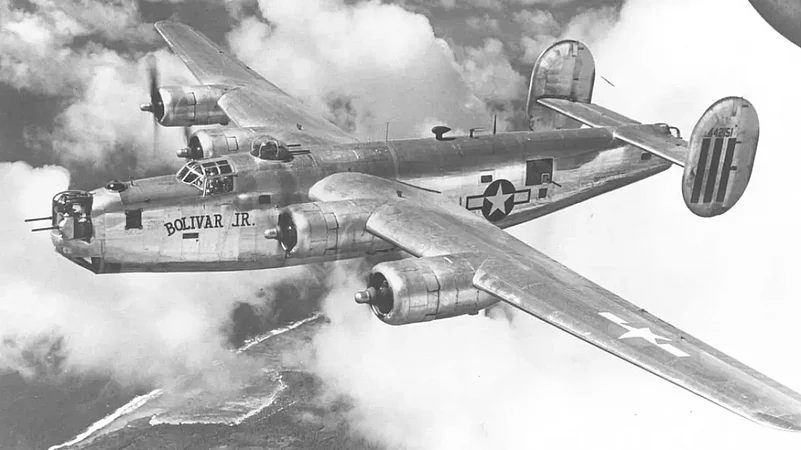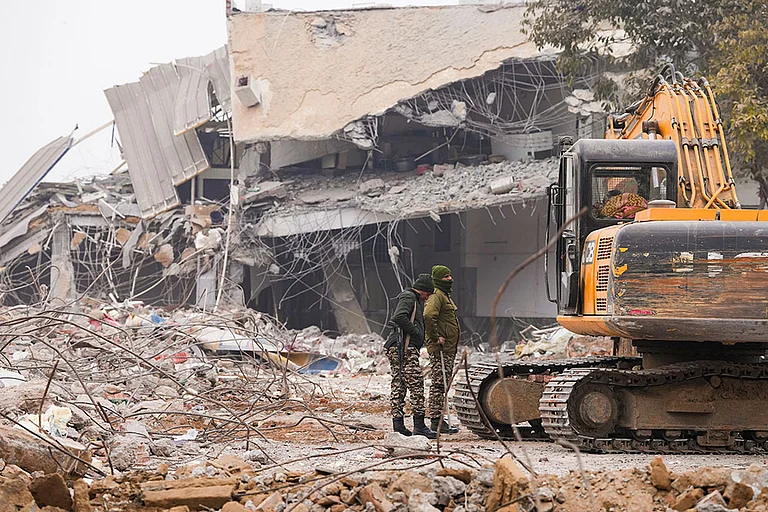This is a story from long ago.
It is an incredible tale of a newly independent nation and its people who had lived a large part of their lives under foreign rule and their idealistic desire to build their own identity. It’s a tale of a generation that had seen two World Wars and an Air Force that had flown under a foreign Flag. It’s a tale of men of great courage and grit, who endeavoured and succeeded against all odds to give their fledgling nation a sorely-needed heavy bomber aircraft when it could not afford one from the world markets.
These incredible men rummaged through an aircraft graveyard and came up with the remains of an iconic World War Two bomber that the world had junked and forgotten. In the stuff of fairy tales, they built two operational squadrons from that junkyard and flew them successfully for the next 20 years. Their names and incredible achievements are now long forgotten, unknown to most today, and therein lies a tale that bears retelling, time and again. Lest we forget!
The story begins at the close of the World War Two in 1945. The world had finally come to the end of one of the longest and bloodiest wars in human history, fought across multiple theatres all over the globe. It was a war that wiped out an entire generation. Those that survived were weary and anxious to go home, almost unbelieving of their good fortune.
In the Eastern Theatre, the British Royal Air Force (RAF) and the US Air Force (USAF) had operated the iconic B-24 Liberator Bombers out of small airfields in Eastern India at Ranchi in Bihar (now Jharkhand) and Panagarh, Dum Dum, Kalaikunda (Kharagpur), and Salua in undivided Bengal and from Chabua, Kumbhigram, and Jorhat in Assam, to attack Japanese military targets in China, Japan, Myanmar and Malaysia. They regularly flew operational missions over the Himalayas and euphemistically called them ‘Flying the Hump’.
After the War, these aircraft could not be taken away to the homeland and were abandoned as junk at Chakeri airfield in Kanpur, Uttar Pradesh. The RAF was given the task of disabling them so that they could never be flown again, as the huge Allied military establishment in India, wound down after the War. And there they lay —broken, forlorn, and abandoned— with weeds and vegetation growing over them, once-proud aircraft that had struck terror in the hearts of the enemy across the globe.
To be fair to them, the RAF tried their best to damage the aircraft and make them unusable. Bulldozers and trucks were rammed into fuselages and cockpit windows, instruments were smashed and removed, and sand was poured into engines. But possibly, in their anxiety to go home, they may have cut a few corners here and there. Of course, no one in their wildest dreams imagined that there would be an attempt to fly those wrecks again. But they reckoned without the resourcefulness, need, and sheer determination of Indians.
Three years later in 1948, during the desperate days of the Kashmir Operations against invading Pakistani forces, the Indian Air Force (IAF) was tasked to assist the Indian Army in repelling the invaders. India had no bombers at the time other than the British Hawker Tempest, a fighter bomber that could barely carry two 1,000-pound bombs under its wings.
Desperate times called for desperate measures and the IAF loaded bombs into the fuselage —body— of Dakotas and literally rolled them off the aircraft without any aiming guidance.
The young country desperately needed a heavy bomber. But its finances just would not support such an ambition. It was then that someone at Air Headquarters thought of the aircraft graveyard at Chakeri and sent out a team to see if something could be salvaged from the wrecks of the nearly 100 B-24 Liberators rotting there.
The team reported back that it might just be possible to make some of them airworthy again by cannibalising parts from other aircraft. By then, production of Liberators had ceased in the United States and no aircraft company was able or willing to supply spares. No manuals were available and the Kanpur Air Force Base had no facilities to even work on these aircraft. They would have to be somehow moved to Hindustan Aeronautics Limited (HAL) in Bangalore —known back then as Hindustan Aircraft Limited— for massive overhaul.
Since the Indian Railways at the time also had no mechanism to transport these huge 67 ft long, 110 ft wide, 29,000-kg heavy aircraft to Bangalore from Kanpur, they were to be somehow made flyable to undertake the near suicidal flight to Bangalore. Chances were that only around 10 per cent of the untested, cannibalised aircraft would make it safely to Bangalore. The rest were expected to perish midway, killing the pilots and who dared to fly them. Qualified American B-24 pilots were contacted, but the fees they quoted for each hazardous ferry was unaffordable for the new nation.
This brought HAL into the picture. From this moment, it becomes an HAL story.
During World War Two, HAL had been part of the war efforts, overhauling Allied aircraft and assembling fighters and bombers of US origin. As such, they had worked on another iconic World War Two aircraft — the Douglas DC-3 Dakota. The DAKs, as they were fondly called, had the same Pratt and Whitney engines as the Liberators.
At this stage, the HAL’s Chief Test Pilot Jamshed ‘Jimmy’ Kaikobad Munshi and a team of HAL engineers under the leadership of a Mr Yellappa stepped up and took charge. This team undertook temporary repairs on the abandoned aircraft to make them flyable for that hazardous initial flight to Bangalore. They taped up cockpit windows, cannibalised parts from other B-24s, and did some basic ‘first line’ maintenance on the engines so that some of those massive aircraft would start.
The intrepid Jimmy Munshi on his part was willing to fly these roughly restored aircraft from a junkyard in Kanpur to Bangalore on what would essentially be suicidal missions. He had never flown Liberators or any four-engine aircraft before, although he had experience of the twin engine DC-3 with its similar Pratt and Whitney engines.
Scouring through the cockpits of the long-abandoned aircraft, Jimmy managed to painstakingly put together an entire flying manual for the B-24s. The story goes that things were so bad that an equally intrepid Mrs. Munshi refused to let her husband fly those missions alone and insisted on accompanying him in the cockpit in the co-pilot’s seat, wearing a fur coat, because the heating system was inoperative.
Jimmy would open full power on the four engines, and if nothing blew up, do some fast taxying around the tarmac to check that the engines were delivering enough power and that the brakes were functional. With minimum fuss, he would then take off from Chakeri to Bangalore —some 1,500 kms away— and fly with undercarriage down throughout the journey. This was because the hydraulic system that operated the undercarriage was unreliable and there was no guarantee that the wheels would come down again once retracted after take-off!
And in this manner, in acts of fantastic courage repeated many times over, Jimmy flew out an incredible 42 Liberators to Bangalore where a team of HAL technicians waited to work on them and undertake a complete overhaul of the iconic aircraft.
It is said that HAL offered to pay Jimmy ‘a handsome amount’ per flight for the risk that he was taking, but he refused, saying he was just doing a job for which he was already being paid. Such was the idealism and nationalistic fervour of the time. India owes a debt to him and to Mr Yellappa and his men for attempting the impossible and making it work.
The rest is history. The HAL put together two squadrons of B-24s and the IAF acquired its first heavy bomber from an aircraft graveyard. They were used in a variety of roles, including maritime reconnaissance in the 1965 India-Pakistan War and even for photographing Mount Everest! The first six refurbished B-24s from the Kanpur graveyard were handed over to No 5 squadron of the IAF —the Tuskers— on November 5, 1948. Together with No 6 Squadron —Sea Dragons— the Tuskers operated these aircraft for the next 20 years until 1969 when they were finally retired from service.
A long-retired IAF pilot who flew them said, “I was lucky enough to fly these iconic aircraft and had the most wonderful experience of feeling the entire aircraft juddering under the power of four Pratt and Whitney 1830 engines at full power! The view from the gun turrets was unbelievable.
“The Dakota and the Liberator were a man's aeroplanes. The feeling of flying them was incredibly powerful and they needed you to be on your toes always. Flying Canberras on operations in a strategic photo recce [reconnaissance] squadron later was a much quieter experience compared to these.”
Around 18,000 B-24s were built during the World War years. Surprisingly, for such a mass-produced bomber that participated in widespread operations in Europe, Africa, China, Burma, and India during World War Two, there were hardly any left for display in museums after the war and almost none in flying condition, except for the ones with the IAF. When they finally retired them in 1968, many air museums around the world clamoured for them.
Today, of the 13 Liberators left in museums there are just two in flying condition and of them is from the IAF. Of these 16, six are from the Kanpur graveyard. These were flown from Pune in 1968-69 in inter-continental flights to museums in the United States, Canada, and the United Kingdom, a testimony to the skills of the IAF airmen who maintained them.
The B-24 Liberator holds a very special place in Indian aviation history and is a tribute to the ingenuity of the Indian engineers who brought them back from the dead and got them flying again. Thanks to them and the intrepid airmen who flew them, the IAF was the last air force to fly these iconic aircraft for a good 20 years after the world had forgotten and abandoned them.
And that is an incredibly proud, never to be forgotten story!



























